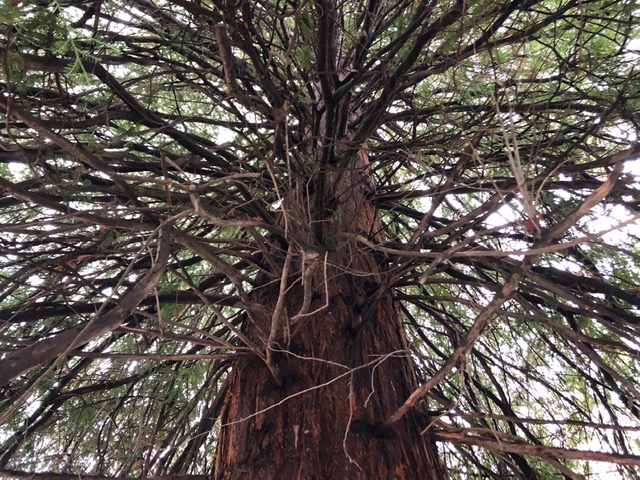
What to watch out for after a major storm

|
|
All those foliage-laden branches on a redwood tree can get heavy when rain collects on them. Check your trees for damage or changes during this stormy period. (Photo: Kathy Morrison)
|
During this break in the rain, it’s time to go outside and check on our landscapes. Thanks to this latest atmospheric river, Sacramento got a lot of much-needed rain, but that saturated soil can create issues, too.
According to the National Weather Service, the greater Sacramento area received between 1.4 and 2.3 inches inches Monday, depending on the neighborhood. Sacramento International Airport recorded 1.46 inches. Meters at Sacramento State measured 1.86 inches. Lincoln got 1.98 inches and Auburn saw 2.32 inches.
And that’s just the start of a wet week. Arriving late Wednesday, the next rain wave is expected to deliver another inch or more.
Although that precipitation does wonders for our water year outlook, it can create dangerous conditions for trees.
Years of drought have significantly weakened the roots of many big trees, particularly large conifers (such as redwoods or firs) as well as elms and birches (one of Sacramento’s favorite lawn trees). Drought literally shrinks a tree’s rootball, so they have less support to hold them upright. Other, often younger trees never had a good anchor in the first place.
Used to shallow watering from sprinklers, solitary “lawn trees” may never develop those strong deep roots. Just under the surface of the turf, lawn trees’ roots are further weakened during drought when lawn irrigation is cut back.
We saw plenty of dropped limbs this week, too. Prolonged drought also causes tree dieback and dead or weakened branches. Those are the first to fall during a heavy winter storm.
But even well-hydrated trees – especially evergreens – can topple over under the right conditions: Saturated soil and big gusts of wind.
During winter, conifers – redwood, pine, fir, spruce, yew, juniper, cypress and their cousins – tend to be at greatest risk. These evergreen trees retain their foliage year-round and can become top-heavy. When it rains, those needles become saturated with water, holding extra weight on a tree’s branches. That foliage also catches the wind like a huge sail.
In the forest, redwoods and other evergreens grow close together; their roots intertwine and help hold each other up. But in the suburban landscape, these big trees often are planted alone, without that extra support.
With more rain and wind expected, now is the time to access the damage – and maybe bring in a professional arborist.
Be careful of trees that may be leaning. If cracks appear in the ground around a tree’s base, stay away – that’s a major danger sign. Put up barrier tape to keep people from walking around it and call an expert.
Need advice? The Sacramento Tree Foundation offers advice on how to hire an arborist: www.sactree.com/hire or call 916-924-8733.
Comments
0 comments have been posted.Sacramento Digs Gardening to your inbox.
Sites We Like
Garden Checklist for week of May 5
Survey your garden after the May 4 rainstorm. Heavy rain and gusty winds can break the neck of large flowers such as roses. Also:
* Keep an eye on new transplants or seedlings; they could take a pounding from the rain.
* Watch out for powdery mildew. Warmth following moist conditions can cause this fungal disease to “bloom,” too. If you see a leaf that looks like it’s dusted with powdered sugar, snip it off.
* After the storm, start setting out tomato transplants, but wait on the peppers and eggplants (they want warmer nights). Pinch off any flowers on new transplants to make them concentrate on establishing roots instead of setting premature fruit.
* Trim dead flowers but not leaves from spring-flowering bulbs such as daffodils and tulips. Those leaves gather energy to create next year's flowers. Also, give the bulbs a fertilizer boost after bloom.
* Pinch chrysanthemums back to 12 inches for fall flowers. Cut old stems to the ground.
* Mulch around plants to conserve moisture and control weeds.
* From seed, plant beans, beets, cantaloupes, carrots, corn, cucumbers, melons, pumpkins, radishes and squash.
* Plant onion sets.
* In the flower garden, plant seeds for asters, cosmos, celosia, marigolds, salvia, sunflowers and zinnias. Transplant petunias, zinnias, geraniums and other summer bloomers.
* Plant perennials and dahlia tubers for summer bloom.
* Don’t wait; plant summer bulbs, such as gladiolus and tuberous begonias.
* Harvest cabbage, lettuce, peas and green onions.